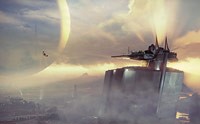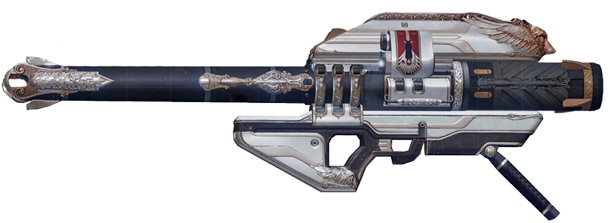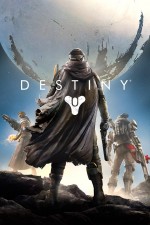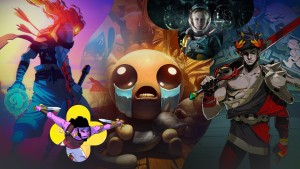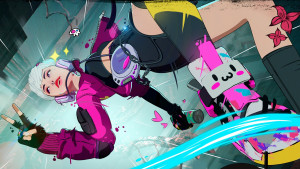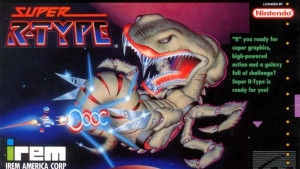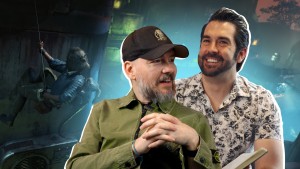Please support Game Informer. Print magazine subscriptions are less than $2 per issue
Destiny
We're rerunning our full magazine cover story on Destiny from the January 2014 issue, without addition or change, so that fans who may have missed the story the first time around can have a chance to check it out. We'll share additional info on Destiny as soon as new details emerge from Bungie HQ. You can read the complete cover story below, but we're also happy to announce that we've now made our entire January issue free on iPad, which includes all of the assets and special interactive features that were part of our original Destiny cover story.
To get your free copy of the Destiny digital issue, download the free Game Informer iOS app, open it, tap the Library tab at the bottom of the screen, and then tap the download button next to the Destiny issue.
For over a year, gamers have known about Destiny. The upcoming sci-fi epic is the next big thing from Bungie, a studio that helped to shape the last two console generations with its Halo series. But for all that time in the public consciousness, Destiny has remained a project defined more by questions than answers. Ask three different fans, and you’ll get three different answers about what the game is – a shooter, an MMO, an RPG. In truth, Destiny is one of the most audacious and risky projects ever attempted in gaming. We should know. We played it, and then dug deep with every branch of the development team to push past the generalizations and get to a concrete answer of what exactly this game is all about.
The shortest answer is that Destiny is an action-focused shooter. Throughout our days visiting Bungie’s sprawling 85,000 square foot studio, different members of the team tell us the same thing. Destiny’s core gameplay is rooted in the studio’s experience with Halo, and our time playing various sections of the game bears that description out. Destiny presents a tight loop of one action scene after another fighting against varied enemies, with lots of toys to make the experience distinct each time. In our experience, Destiny never loses sight of its fundamentals – fast, reactive, and intense first-person combat. But from this core it expands in bold new directions. “We’re trying to build a game that we have wanted to play that doesn’t exist,” says Bungie co-founder and design director Jason Jones. “I think that’s really the genesis of Destiny. When you look out at the shooter experiences on consoles, there are a lot of great action experiences, but they’re only starting to scratch the surface of cooperative play, aspirational goals, and player-to-player -interaction.”
What sets Destiny apart is its ambition. On top of its shooter essence, Bungie is layering those other features that have made the project so hard to define. Characters level up along branching upgrade trees, story plays a central role in everything you do, and personalization of character appearance, gear, and vehicles is vital, just like in role-playing games. Its persistent world and multitude of ways to play with other people call to mind the MMO genre. “MMO is a loaded term; it always puts some mental image in people’s heads about what the game is,” says technical art director Ryan Ellis. “Our game is different, and kind of hard to describe, which is why we don’t use that term. But I do think that people who like that sort of thing are going to find things to love in this game.”
The scope of Destiny is suitably impressive to warrant its presumptive role as a flag-bearer for next-generation software. That scope is still a work in progress, with months of work ahead that will determine its success. However, Bungie certainly has the groundwork in place. Nearly 500 developers now call Bungie home, all working together over the last five years to make Destiny a reality. The art team alone is pushing 150 individuals. This level of investment of resources and manpower would have been unheard of in the gaming industry just a few short years ago, but it’s necessary to redefine expectations for an online-enabled shooter.
Much of what we saw and played during our two-day visit to Bungie was brand new to us – from the competitive multiplayer to the detailed look at how character investment and progression functions. Other things we learned were like filling in missing colors in a painting, revealing new details on enemy sub-groups, weapons, and setting. The picture that developed is an amalgam of experiences that finally starts to present a comprehensive understanding of Bungie’s new adventure.
Next Page: Creating A Hero
Custom Built: Bungie wants players to personalize their character at every step of development. Take a look at just some of the variety available for your guardian’s visual style.
BUILDING A GUARDIAN
Most shooters (including Bungie’s previous Halo work) establish a static character with a distinct set of abilities, and set that character loose within the story. A few, like Borderlands or Mass Effect, offer more opportunities for choice. Destiny aims to broaden that scope of choice with a flexible suite of character-creation tools and upgrades that leave room for rebuilding your character without losing previous progress. The game also includes the opportunity to create guardians in multiple character slots, ensuring replay potential without sacrificing progress.
During character creation, your guardian starts out with several basic choices. Your race is a cosmetic decision; the face you present in the shared, non-combat spaces of Destiny where you roam without wearing a helmet. Humans offer an uncomplicated and familiar experience; they are survivors of the Collapse picking up the pieces of civilization. The Awoken also survived the Collapse, but were forever changed; they appear otherworldly and aloof. Finally, the exo are self-aware machines built during humanity’s Golden Age; they have been rebooted with no memory of their original purpose, and come across as unyielding and tireless. Each draws on familiar fantasy and science fiction archetypes. In addition to race, you pick a gender, and customize your face, hair style, and even tattoos to help set your guardian apart.
Choosing your class sets the tone for your experience. “We’re doing something that’s a little different from normal RPGs in which each class has a strongly defined role,” says investment lead Tyson Green. “If you want to think about it in MMO terms, all of our classes are damage-per-second characters. Every character is capable of going into a situation and solving it. They may do it in different ways. The class is really more of an emotional archetype.” While your choice between titan, warlock, and hunter establishes the style of abilities that follow, it doesn’t determine the -abilities -themselves.
That designation comes from your focus. Each guardian bears a class-specific focus, which in practice functions like a sub-class. Focuses are the primary way you level and improve characters. Each focus advances from level one all the way up to twenty, with new abilities, passive bonuses, grenade types, and more unlocking over time. “The focus is the thing that carries all your abilities,” Green explains. “[It] allows you to take the Traveler’s light and turn it into effects in the world. The focus defines how you’re going to be playing the game right now, much more so than your class.”
You shape your focus’ abilities as you level, and each upgrade tree is distinct. In any given focus, one tier offers a selection of grenade types, including everything from homing to proximity options. Another choice determines your vertical movement mode, like a short-range teleport or a double jump. Yet another tier offers a choice about melee bonuses. Weapon specialties, passive bonuses, and upgrades to your focus’ super ability are also on the table.
Next Page: More On Focuses
Every class has numerous focuses to acquire and develop, each with its own specialties. However, unlike a traditional MMO character build, your focus is effectively a piece of equipment that can be changed out at will, like selecting a new weapon. “You can think of the focus as carrying the character level – a different way of approaching level,” Green says. “We didn’t want players to have the sense that they were creating a disposable character. We didn’t want people to be leveling a character up to 20 and then deciding to try something different, and then being forced to throw themselves away. That sucks. We looked for a different way to approach that problem.” One focus could be built out for your preferred competitive multiplayer loadout, while a second healing-oriented focus could be reserved for cooperative raid work.
Each class represents a particular player fantasy. Warlocks draw on the power of the mysterious Traveler to create impressive spell effects, but they’re not like casters in many games that never get to enjoy the big guns. Instead, just like everything in Destiny, the core experience always comes back to time-honored shooting gameplay. Warlocks just get to throw in some cool mystical powers along the way. Each class has one piece of gear unique to them. For warlocks, their robes set them apart. Warlocks begin the game with the Circle of Night focus – a glass cannon with an impressive suite of damage-dealing skills, but less protection when the fight gets heated. This focus’ super ability is the nova bomb – a devastating burst that can often wipe out whole groups of enemies from a distance. Alternately, you might level up your Heart of Fusion warlock focus. This support-focused build uses the radiance super ability to revive and buff allies.
Titans sit at the opposite end of the spectrum – the heavily armored look harkens to Bungie’s previous fixation on space marines and powered metallic suits. They’re all about busting in and breaking through, and likely taking a little more damage in the process. The badges they wear run down one leg like a sash – a symbol of honor earned in battle that is unique to the class. You start out with a focus centered on close-quarters devastation, built to handle the punishment it takes to get in next to enemies and then deploy a super ability, called Fist of Havoc, that creates a resounding shockwave. Later upgrades make the shockwave even more powerful, adding electrical or damage-over-time areas that remain in place even after you leave.
The Hunter bridges the gap. These pistol-spinning bounty hunters stalk their prey with skill and precision. Visually, they are a mix of the other two classes – a 50/50 split of cloth and metal. Their class-specific cloaks make them look like space cowboys. You begin the game with the gunslinger focus, perfect for high value single-target damage. In a pinch, you can pull out your super; the ghost gun is a fearsome mystical weapon that can one-hit kill most opponents. Perhaps later you’ll upgrade ghost gun with an immolation perk.
Before you head out exploring, your guardian also needs gear to capitalize on your chosen focus. “Focuses are meant to be synergistic with the gear that’s available,” Green says. “You’re starting with a character, taking a focus, and then starting to find the armor and weapons that work the best with that focus.” A primary weapon, secondary weapon, and heavy weapon each have color-coded ammo types to find in the field, and you carry one of each type into play. Like your focus, you set the weapon you want for any given scenario before heading into the fight, picking from an arsenal you’ve acquired over the course of your journey. In addition to class-specific armor, you also need to select a helmet, arm protection, torso armor, and leg equipment – each of which carries its own bonuses and abilities.
Three additional pieces of gear finalize your character. Your ghost is an accompanying AI companion – a floating metal device that serves multiple roles, such as being a flashlight in dark places. A customizable personal vehicle looks and functions like the speeder bikes from the Star Wars movies, and you can hop on these non-combat vehicles to zip between locations in the large, open-world environments. Finally, you have a personal spaceship. Each guardian’s ship is different. Bungie says Destiny is not about space combat, but your ship is still frequently on display to other players. As your home away from home, your ship is visible as you warp from one planet to the next, and you see it hanging in orbit with other guardians’ ships before a shared competitive or cooperative match – a bragging point that shows off your style and accomplishments.
| EXPLORING THE SOLAR SYSTEM |
|
Generations ago, the Traveler came to the solar system and prepared the way for humanity’s expansion into the stars. It reshaped planets and moons, and taught us new technologies and mystical powers that led to a golden age. Then the Traveler’s ancient enemy returned. The mysterious Darkness swept through the system, devastating civilization and leading to the Collapse. Few humans survived, due only to the intervention of the Traveler, leaving one last city on Earth protected from devastation. Now, many years later, humanity’s guardians are departing the safety of the City to reclaim their legacy across Earth and its many neighboring celestial neighbors. Each location in Destiny is a grand open space for exploration, adventures, and discovery. These first five destinations are a sampling of what’s to come; Destiny’s fiction clearly establishes all the planets, moons, asteroids, and other features of our solar system as fair game for exploration. “There is an overarching storyline to Destiny, but a lot of the story of Destiny is about these places that you go to,” says technical director Chris Butcher. “What happened on the Moon? Who are the factions and the groups of aliens there? What are they trying to do, and what are you trying to do?” While players will explore many areas of Earth in the long-term Destiny storyline, the first major location is Old Russia. Specifically, guardians explore the devastated ruins of the Cosmodrome and its surrounding area – a real-world site in modern-day Kazakhstan that has long been the launch site for the Russian space program. In the Destiny fiction, the Cosmodrome remained a vital link to outer space during humanity’s golden age, and players can see the remnants of forgotten colony ships left on the launch pad during the cataclysmic Collapse. Orange, burnt grass steppes and dimly lit interiors of old buildings are a magnet for invading Fallen soldiers. Crackling lightning flashes through the sulfuric yellow sky, and the jungle has grown over the remnants of the scientific research settlement that humanity once held here. Now, the city’s buildings are slowly being swallowed up by the Venusian ocean. Instead, the towering Vex citadel now draws the eye – a hulking obelisk Jenga tower of weird geometric shapes. Its purpose remains unknown, but the robotic Vex unceasingly defend it. A thriving metropolis once dominated the skyline of Mars, a bastion of human life in the red dunes. That city now lies buried beneath a mountain of sand, and only the once-soaring skyscraper peaks are visible. Guardians can climb into those upper windows and delve down toward what was once ground level. Along the way, you’re likely to see the heavily entrenched armies of the Cabal blocking your way. The Vex are also at odds with the Cabal, and it won’t be unusual to see the two forces in combat with one another. The quintessential home base, the Tower is the place where guardians return under the shelter of the Traveler. This large hub stronghold is described as Earth’s Camelot – a glimmering stronghold surrounded by shadow. You can visit vendors, turn in quest items, and interact with fellow players in large, open plazas. The Tower also houses class-focused areas for titans, warlocks, and hunters to each meet with their fellows. The forces of the Hive have infested Earth’s moon, and pieces of the surface have cracked and broken off into space. The moon once housed a thriving human colony of interconnected bases, but now only broken domes and scattered space suits half-buried in the lunar soil mark humanity’s faded dominance. An iconic view of the looming Earth hangs in the skybox, but guardians would be wise to keep their eyes closer to the ground. A massive hellmouth gapes open where the Hive began their dig, and sprawling networks of caves and fortified strongpoints wait inside. Out on the surface, forgotten treasures hide in the dust. |
Next Page: Wandering the solar system
SETTING OUT
While Destiny offers a robust multiplayer experience, everything branches out from the exploration, leveling, and shooting. Destiny encourages you to move in and out of interactions with other players at your leisure, but you can also spend entire sessions tackling story missions and side content without the aid of others. “There is a very defined storyline, with a beginning, middle, and end,” says head of community Eric Osborne. “For those who want to binge and concentrate on story, you can have what feels like a very directed, cinematic experience.”
The integration of solo adventuring and multiplayer comes together through some clever technology that constantly handles matchmaking in the background. “For Halo, the party system and Xbox Live was important, but it was just one part of the game,” says technical director Chris Butcher. “It was a mode you went into. With Destiny…the whole game is match-made, in one sense. When you are going through these public areas, we have that technology running all the time invisibly.”
Unlike many MMOs that run on separate servers, Destiny has all players together in one massive world, and seeks to link you with small groups of other players at appropriate locations and times. “There’s all these things going on in the spaces, and our hope is that players won’t need to think about it,” Butcher says. “It will just be a place to go to, and that place is always filled with things to do and people to do them with.”
Many spaces are set aside for you or a chosen fire team of up to three friends playing together, and other players won’t arrive to interrupt those battles, story scenes, or missions. “Three people is a very natural number for cooperative gameplay,” Butcher says. “Two people is certainly interesting, but the third person makes it into a real team experience – a really nice, social dynamic.”
Meanwhile, other locations are designated as public areas, and the game seamlessly introduces additional players to scale to the challenge at hand. For instance, a few fire teams might be thrown together in a large open space to confront an invading Husk Wizard. Unlike some MMOs, in which dozens of players could swarm a public boss, the battle is appropriately challenging, since the game limits the population of players in any given instance of a space. Afterward, you can depart the public area and progress alone, or continue on with a small group of friends. “You’re continually moving around between these groups of consoles and dedicated servers that are hosting it,” Butcher says. “That’s the thing I’m really excited that we’ve been able to do.”
Next Page: A trek to Old Russia
A tour through Old Russia offers a clear representation of free-roaming flow. Some may remember the E3 demo of Destiny. A scripted mission played out underneath a massive wall, ending in a larger public battle against a Fallen tank mech. However, turn a few different corners, and you emerge beyond the wall into a free-roaming countryside. Small squads of Fallen soldiers lurk in the ruins of half-buried tanks and old ramshackle buildings. You stop at a few groups and fight your way through them, flinging grenades, dropping supers, and sending bursts from a pulse rifle. With each kill, an XP counter ticks up, and all your currently equipped gear (including your focus) moves a step closer to the next level. As you explore, a few enemies are clearly beyond your gear level – your gun doesn’t make a dent in their armor, so you move on. You’ll be back for -them -later.
With a button press, you hop on your personal vehicle and skim across the grasslands at high speed. Off to the side, a small sea gleams in the sunlight, with ancient rusted ship hulks jutting up from the shoals. Your target is a building called the Array, but when an ambient mission pops up to kill a certain number of Hive and Fallen enemies in the area, you stop to tackle some fights. “It’s not just a bright line through story,” Osborne says. “We want people to come back to these places, explore, find new places to go, and have new reasons to -come -back.”
The shooting in Destiny should feel second nature to longtime Halo players. “Responsive action gameplay is always the core of what we do,” Ellis says. “We always make decisions to keep that true. We never want anything that introduces too much latency into the controls. We never want to sacrifice the feel of shooting a weapon, throwing a grenade, or driving a vehicle.” In the control scheme we witnessed, movement, camera, and shooting all map to the expected sticks and buttons. The left trigger is a designated ironsights button, available on all weapons. The right bumper is a quick melee attack that is different for each focus. A click of the left stick triggers sprint. The top face button still changes weapons between primary and secondary armaments, but hold down the button and you brandish your chosen heavy weapon. The left bumper flings out a grenade, distinct to your focus, such as a seeking grenade that homes in on targets. After you throw, a quick timer meter fills before another grenade is ready. Tap the bottom face button to jump, and tap it again to trigger your focus’ movement mode, such as the warlock’s parabolic glide. Finally, hold down both bumpers and you get the satisfying wind-up for your super, which is always a potent attack, buff, heal, or other action that can turn the tide of a fight. These features help Destiny stand apart. Every class and focus has its own special grenades, supers, bonuses, and upgrades, lending a variety to the visual style and gameplay of any given fight.
After taking out several enemies in the area, a public mission shows up to escort a nearby VIP to safety, but you decide instead to bypass the mission and continue to your destination. You hop on a Fallen vehicle with cannons on the front to close the distance, and then disembark to go inside. The building you enter offers a more linear path to your objective – in this case a patrol to check for infiltrators. It could just as easily be a mission to defend a checkpoint or track down a gun upgrade. The enemy soldiers you take down drop glimmer, the currency of Destiny – a rare, energy-based substance left over from humanity’s golden age.
With your Array patrol complete, you emerge back into the sunlight a few steps away from a public event. A high-level named Fallen Captain is being hammered by half a dozen fellow guardians, and you join in on the fight. “We think of the game as being structured in terms of activities,” Butcher says. “Depending on your mood, you choose an activity that suits that mood. You’re going to a place, and you have a reason to be there. Sometimes that reason is more open ended, and sometimes it’s very directed. But you always have an activity.”
These moments of free exploration and random missions are ideal for some game sessions, but alternately, Destiny has a separate, targeted entry portal into the action. You can pull up a screen-filling game map littered with icons for story missions, cooperative strikes, competitive matches, and more. If you’re in the mood to tackle one particular play style, this map gives you instant access, and your ship zooms out of orbit to reach the site of the action. You decide to tackle some directed multiplayer, and moments later you’re in a mission far from Earth.
Next Page: The multiplayer promise fulfilled
JOINING UP
Your chosen cooperative mission takes you to a cave mouth on the surface of the moon. The game mode is a strike – a cooperative adventure ideal for pick-up groups or friends looking for a quick battle together. Coordination won’t be an absolute necessity for success, but it certainly helps.
You enter the Pit of Chains with your companions beside you, and it’s not long before shambling Hive Troopers detect your presence. In the first big fight of the strike, you and your fellow guardians must hold off waves of foes as a nearby door slowly unlocks. Your group gets separated and quickly overwhelmed. It’s a wipe. However, a generous checkpoint system pops you right back at the start of the fight, and a modicum of teamwork is enough to win the day the second time around. With your foes defeated, you tap a direction on your d-pad, and your guardian exhibits a cheering animation, which is returned by your buddies.
Beyond the unlocked gate, you find a massive cavern filled with teeming hordes of Hive soldiers, but this time you have more help. The area is a designated public space, so a couple of other fire teams join in as you work your way across -the -cave.
Leaving the other players behind, your fire team continues deeper into the dungeon, and eventually encounters the final boss of the strike – a raging Hive Ogre. Concentrated fire from your team whittles away at its health, while other monsters spawn to distract you. You leap from a cliff top towards a distant ledge, and use your short-range teleport to cross the distance. From here, you’ve got a good angle on the giant, and one final nova blast sends the creature tumbling to the ground. With the strike complete, you pick up an intriguing new fusion rifle left behind by the ogre. The dynamic loot system provides distinct treasure for every player in the group. With your rewards in hand, your team is instantly transported back into orbit.
From orbit, you decide it’s time to test out the new gear against your fellow players, and proceed into several games of competitive multiplayer. Within the fiction, guardians fight against one another in support of various competing factions in the City, and battles play out in contested areas across the solar system. “You are being employed by these factions,” says design lead Lars Bakken. “The factions helped and were integral to the forming of the city. They are very interested in pushing guardians out into the universe, and helping them to reestablish and take back these places.”
Competitive game modes in Destiny run the gamut, and show the same flair for clever construction that Bungie is known for, both in concept and environment design. One battle pits groups of fire teams going head-to-head in a straightforward area capture style; holding any of the three points gives you scoring multipliers for kills, assists, and other actions.
After a few games capturing zones, you head into a smaller, deathmatch-style mode with an interesting tactical layer; points are awarded for kills, but also for finding your downed teammates and reviving them before they respawn – presuming your enemies aren’t camping the corpse.
Guardians begin competitive matches without access to heavy ammo, and occasional drops of the precious pick-ups are focal points for action. Maps have lots of verticality, and it’s easy to reach high ledges thanks to the wide variety of vertical movement modes available to each class. Shifting environmental features add complexity, like giant mechanisms that move to alter sight lines, or even using the glare from the distant sun to approach an enemy unawares. The broad range of grenade types and supers on display keeps everyone on their toes, but ultimately the action is still focused on quick reflexes and smart weapon use. “When you play Destiny, if you are just interested in competitive multi-player, we are going to scratch that itch,” Bakken says. “There’s going to be an awesome amount of stuff for you to dig into and play. But we’re going to balance that with the fact that we’re giving players a bunch of other new activities as well.”
| A WEAPON FOR ANY OCCASION |
|
Including your focus, gear in Destiny is the primary way to set yourself apart from fellow players, and you spend a lot of time working to acquire new equipment and improve existing pieces. “When you get a new piece of gear, you’re always making decisions about how is this going to help me?” says technical art director Ryan Ellis. “Is it going to enhance the abilities I already have? Is it going to improve the weapons I like to use? Is it going to make me tougher? Or faster?” Weapons and armor profiles offer basic data that communicate damage or defense potential, but most items are more descriptive than focused on incremental differences in numbers. You’re more likely to change to a different helmet because it boosts a certain potent ability, rather than because its numerical value is some small percentage point better than your existing headwear. Like a focus, gear items have their own short upgrade tree, and your item gets better and even acquires new abilities the longer you use it. Gear is loosely gathered into four tiers: basic (white), common (green), superior (purple), and the coveted exotic items (gold). Characters can only wield one exotic weapon and one exotic armor piece, but you can carry as many as you like, and switch between them at your leisure. Exotics are game changing in their power, and might dramatically alter your playstyle. The following three exotic weapons help show off the variety in offensive options, but armor exotics are equally powerful and varied, like a helmet that might dramatically reduce all headshot damage you receive.
Red Death
Closing Time
Gjallarhorn |
Next Page: A glimpse into the end-game
BEYOND THE HORIZON
Like a traditional single-player shooter, Destiny features a cinematic story with a clear conclusion, but Bungie hopes to keep you invested long past that story’s completion. The cooperative, competitive, and solo gameplay we witnessed was just a smattering of the tantalizing game modes and missions visible on the wider map. Some of that content is purposefully built as aspirational – modes and locations that require powerful gear and heavily leveled focuses. Included in the mix are highly challenging raids – cooperative story missions meant to be tackled by organized groups against seemingly insurmountable odds. “There are activities that will push you harder and further than you’re ready for at the beginning or even the mid-level of the game,” Bakken says. “So, when you start to get to the end of the first initial story we release, there are multiple places to spend time with your high level characters. It won’t just be raids, but other activities shift into a mode where they’re more about high level play.”
While the initial release of Destiny is promised as a story in its own right, it’s clear that Bungie is building the game for a long haul. Subsequent new locations, storylines, and other content are virtually guaranteed. “We definitely plan on making sure that the world is updated and alive over time,” Butcher says. “We’ve designed the world of Destiny to be a place where we can tell a lot of stories. We think of Destiny as being an ongoing conversation with our players.” No matter how Activision and Bungie decide to monetize that new content, one thing is for sure. “We’re not charging a subscription fee for Destiny,” Butcher confirms. As you wait for new adventures to show up, perhaps you’ll embrace the challenge of rising through the competitive ladders. Maybe the game becomes a go-to option for your friends to tackle cooperative challenges. Destiny is built to encourage replay and long-term investment in your character and the wider story.
When discussing an upcoming game, especially from a time-tested developer like Bungie, it’s tempting to be carried away by the simmering potential of the project. Undoubtedly, features can change, technology can fail to pan out, or storylines can fizzle. However, Destiny’s sheer breadth and depth stands out as one of the most daring experiments in modern game development. Drawing from conventions established in a handful of other genres, Bungie is shaping an experience that plays unlike anything else. Your anticipation and excitement is justified; start planning your journey into the unknown.
Want the full picture on Destiny? We’ve got an interview with Bungie co-founder Jason Jones, more information on matchmaking, details on the Destiny soundtrack, and much more on our cover story hub.









